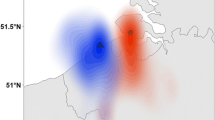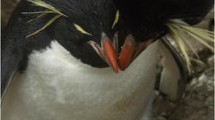Abstract
We used radio telemetry and observations to study the activity patterns and behavior of gentoo penguin chicks at Admiralty Bay, King George Island, South Shetland Islands in 2005 during their “fledging period”; defined as the time between a chick’s first trip to sea and its final dispersal from the breeding colony. Gentoo penguins exhibited delayed dispersal of young and extended parental provisioning, behaviors not observed in other Pygoscelis species. Chicks took their first trip to sea at a mean age of 70 days of age, before finally departing the colony at a mean age of 82 days. During this fledging period, individual chicks made an average of five trips to sea. Trip duration increased significantly as chicks aged, with trips to sea becoming similar to literature values of adult foraging trips in both timing and duration. Behavioral observations and mass dynamics confirmed that many chicks were still being fed during this fledging period, with parental feeding behaviors most often observed in the late afternoon to evening hours. We hypothesize that these behaviors provide an opportunity for chicks to gain experience at sea prior to dispersal and might allow them to develop foraging skills before they are completely independent.





Similar content being viewed by others
References
Ballard G, Ainley DG, Ribic CA, Barton KR (2001) Effect of instrument attachment and other factors of foraging trip duration and nesting success of Adélie penguins. Condor 103:481–490
Bost CA, Jouventin P (1990) Evolutionary ecology of gentoo penguins (Pygoscelis papua). In: Davis LS, Darby JT (eds) Penguin biology. Academic Press, San Diego, pp 85–112
Bost CA, Jouventin P (1991) The breeding performance of the Gentoo penguin (Pygoscelis papua) at the northern edge of its range. Ibis 133:14–25
Burger J (1980) The transition to independence and postfledging parental care in seabirds. In: Burger J, Olla BL, Winn HE (eds) Behavior of marine animals, marine birds, vol 4. Plenum Press, New York, pp 367–447
Castillo-Guerrero JA, Mellink E (2006) Maximum diving depths in fledging blue-footed boobies: skill development and transition to independence. Wilson Bull 118(4):527–531
Croll DA, Jansen JK, Goebel ME, Boveng PL, Bengtson JL (1996) Foraging behavior and reproductive success in chinstrap penguins: the effects of transmitter attachment. J Field Ornithol 67(1):1–9
Croxall JP (1984) Seabirds. In: Laws RM (ed) Antarctic ecology. Academic Press, New York, vol 2, pp 533–620
Croxall JP, Prince PA (1987) Seabirds as predators on marine resources, especially krill, at South Georgia. In: Croxall JP (ed) Antarctic ecology. Cambridge University Press, Cambridge, pp 347–368
Despin B (1977) Croissances compares des poussins chez les manchots du genre Pygoscelis. C R Acad Sci Paris D 42:1135–1137
Dobson FS, Jouventin P (2003) Use of nest site as a rendezvous in penguins. Waterbirds 26:409–415
Hinke JT, Watters GM, Salwicka K, Trivelpiece SG, Trivelpiece WZ (2007) Divergent responses of Pygoscelis penguins reveal common environmental driver. Oecologia 153(4):845–855
Hintze J (2004) NCSS and PASS. Number cruncher statistical systems, Kaysville, Utah. http://www.ncss.com
Jouventin P (1982) Visual and vocal signals in penguins, their evolution and adaptive characters. Paul Parey, Berlin
Lescroel A, Bost CA (2005) Foraging under contrasting oceanographic conditions: the Gentoo Penguin at Kerguelen Archipelago. Mar Ecol Prog Ser 302:245–261
Nelson JB (1978) The Sulidae: gannets and boobies. Oxford University Press, Oxford
Sander M, Balbão TC, Costa ES, dos Santos CR, Petry MV (2007a) Decline of the breeding population of Pygoscelis antarctica and Pygoscelis adeliae on Penguin Island, South Shetland, Antarctica. Polar Bio 30(5):651–654
Sander M, Balbão TC, Polito MJ, Costa ES, Carneiro APB (2007b) Recent decrease in chinstrap penguin (Pygoscelis antarctica) populations at two of Admiralty Bay’s Islets on King George Island, South Shetland Islands, Antarctica. Polar Bio 30(5):659–661
Trivelpiece WZ, Bengtson JL, Trivelpiece SG, Volkman NJ (1986) Foraging behavior of gentoo and chinstrap penguins as determined by a new radio telemetry techniques. Auk 103:777–781
Trivelpiece WZ, Trivelpiece SG, Volkmann NJ (1987) Ecological segregation of Adélie, gentoo and chinstrap penguins at King George Island, Antarctica. Ecology 68:351–361
Volkman NJ, Trivelpiece WZ (1980) Growth in pygoscelid penguin chicks. J Zool 191:521–530
Williams TD (1990) Annual variation in breeding biology of gentoo penguins (Pygoscelis papua) at Bird Island, South Georgia. J Zool 222:247–258
Williams TD, Rothery P (1990) Factors effecting variation in foraging and activity patterns of gentoo penguins (Pygoscelis papua) during the breeding season at Bird Island, South Georgia. J Appl Ecol 27:1042–1054
Woehler EJ, Cooper J, Croxall, JP., Fraser WR, Kooyman GL, Miller GD, Nel DC, Patterson DL, Peter H-U, Ribic CA, Salwicka K, Trivelpiece WZ, Weimerskirch H (2001) A statistical assessment of the status and trends of Antarctic and sub-Antarctic seabirds. Report on SCAR BBS workshop on Southern Ocean seabird populations. Montana: SCAR, p 45
Acknowledgments
We thank Raytheon Polar Services for logistical support in Antarctica; S. Agius, C. Lin and S. Woods provided field assistance. C. Reiss provided valuable help with the preparation of this manuscript. This manuscript was much improved by the comments of S. Emslie, J. Hinke, A. Miller and four anonymous reviewers. References to trade names do not imply endorsement of these products. This research was funded by a grant to W. Trivelpiece from the US National Science Foundation (OPP 0344275). Additional support from the Lenfest Ocean program of the Pew Charitable Trusts is gratefully acknowledged. This work complies with, and was completed in accordance to, an Antarctic Conservation Act permit provided by the US National Science Foundation.
Author information
Authors and Affiliations
Corresponding author
Additional information
Communicated by P.W. Sammarco.
Rights and permissions
About this article
Cite this article
Polito, M.J., Trivelpiece, W.Z. Transition to independence and evidence of extended parental care in the gentoo penguin (Pygoscelis papua). Mar Biol 154, 231–240 (2008). https://doi.org/10.1007/s00227-008-0919-x
Received:
Accepted:
Published:
Issue Date:
DOI: https://doi.org/10.1007/s00227-008-0919-x




